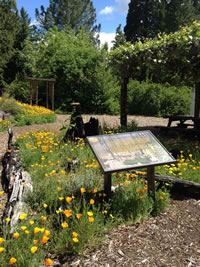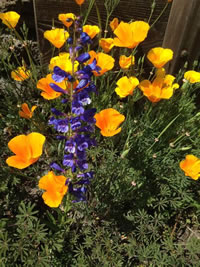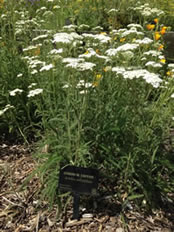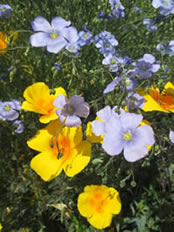Pacific Southwest Region Viewing Area
LOCATION and PHOTOS
 The fire-dependent garden bed hosts a show of California poppies against the backdrop of a native California grape arbor.
The fire-dependent garden bed hosts a show of California poppies against the backdrop of a native California grape arbor.
 Silver bush lupine blooming and starting to make fruits in May 2016.
Silver bush lupine blooming and starting to make fruits in May 2016.
 Showy penstemon (Penstemon speciosus), grown from seed collected north of Mt. Shasta, surrounded by California poppies and lupine leaves.
Showy penstemon (Penstemon speciosus), grown from seed collected north of Mt. Shasta, surrounded by California poppies and lupine leaves.
 The entrance to the interpretive garden, outside our propagation greenhouse, has a great show of pollinator friendly plants.
The entrance to the interpretive garden, outside our propagation greenhouse, has a great show of pollinator friendly plants.
 Picnic tables invite visitors in the shade of the California grape arbor.
Picnic tables invite visitors in the shade of the California grape arbor.
Mt. Shasta Interpretive Garden: Highlighting Native Plants for Pollinators
Forest: Shasta-Trinity National Forest
District: Shasta-McCloud Management Unit
Description: In Mt. Shasta, California, the Shasta-Trinity National Forest native plant interpretive garden features local native plants for pollinators. Other highlights include plants that provide food and cover for wildlife, and fire-dependent species, northern California endemic plants, and plants traditionally used by local Native Americans.
The garden displays some of our most important local habitats including the eastside pine forest, Klamath mixed conifer forest, oak woodland, serpentine barren, subalpine meadow, and riparian aspen grove. Each of these habitats is home to a variety of wildflowers and flowering shrubs, which naturally attract native birds, butterflies, bees and other pollinators.
Two rare bumblebees, Franklin’s and Western (Bombus franklini and B. occidentalis), have been found in the Mt Shasta area and surveys for them are conducted during the summer months. Flowers in the garden attract a variety of bumblebees and provide ample opportunity for people to develop bee identification skills. Butterflies also abound in this garden and a large patch of showy milkweed (Asclepias speciosa) each year attracts monarch butterflies, which depend on milkweed to feed their young.
Wildflowers in the garden beds include a variety of penstemons (Penstemon spp.), sulfur buckwheat (Eriogonum umbellatum), woolly sunflower (Eriophyllum lanatum), wild strawberries (Fragaria virginiana and F. vesca), fireweed (Chamerion angustifolium), flax (Linum lewisii), silver lupine (Lupinus albifrons), columbine (Aquilegia formosa), dogbane (Apocynum androsaemifolium), and leopard lily (Lilium pardalinum), to name just a few. The flowering shrubs include western azalea (Rhododendron occidentalis), pink flowering currant (Ribes nevadense), roses (Rosa species), mock orange (Philadelphus lewisii), blue elderberry (Sambucus nigra), western chokecherry (Prunus virginiana var. demissa), Klamath plum (Prunus subcordata), clematis (Clematis lasiantha and C. ligusticifolia),coffeeberry (Rhamnus californica), Douglas spiraea (Spiraea douglasii), hazelnut (Corylus cornuta var. californica), and Pacific and red-stem dogwoods (Cornus nuttallii and C. sericea). Many of our local bunchgrasses are also represented in the interpretive garden.
The garden was built in 2008 and planted on a shoestring budget by the ingenuity of the botany and greenhouse staff. Volunteers work throughout the growing season to keep this garden maintained and beautiful. A shallow pond was built in 2009 and is used regularly by our resident quail population. In 2015, a new garden bed was added to highlight the rare bumble bees mentioned above and signage with more information is planned.
We invite the public to stop by and learn about these flowering plants and our local pollinators while visiting the forest. Local gardeners will not only appreciate the beauty of our wildflowers, but also the potential for water conservation by using drought tolerant species. Visitors can linger in each habitat area and learn from the interpretive signs that explain important ecological processes and interconnections among plants, people, and wildlife.
Directions: The display garden is adjacent to our greenhouse and plant propagation grounds on the Forest Service compound just two minutes off Interstate-5, approximately one hour north of Redding, California, and 45 minutes south of Yreka, California. Take the central Mt. Shasta exit (#738) into town and go straight through the first light and turn left on Pine (the next street). At the stop sign turn right to park in front of the main office, or go straight at the stop sign and turn right into the Forest Service back parking lot.
Ownership and Management: U.S. Forest Service, Shasta-Trinity National Forest, Shasta-McCloud Management Unit Office in Mt. Shasta (530) 926-9611; Botany & Greenhouse Office (530) 926-9645.
Closest Town: Mt. Shasta, California.







